Human digestive system is the collection of organs that work together to break down food. It is also called the digestive tract or GI tract. Human digestive system consists of many parts; mouth, pharynx, oesophagus, stomach, small and large intestines, rectum, liver, gallbladder, pancreas and many other parts attached to these. This digestive system for kids lesson will teach you all about the human digestive system.
If you really want to grow well and live a healthy life until your death, it is so much the better to have a good understanding about your digestive system and how it works. So, this lesson, human digestive system for kids, will give you lots of interesting facts about your digestive system.
Contents: (Click the links in the contents to find and read what you want easily.)
First, let’s see the definition of digestive system.
The collection of organs that work together to break down the food you eat into energy and basic nutrients to feed the entire body is called the digestive system.
The digestive system in your body is a food factory production line. It is also know as;
Click to go back to the contents
The digestive system begins in the mouth. Oesophagus, stomach, small intestine, large intestine and anus complete the digestive system along with the other parts pancreas, gallbladder and the liver. The digestive system ends up at the anus (the opening in your bottom).
Click to go back to the contents
Step 1:
Your digestive system process begins to work by producing saliva even before you eat the first bite of food. Also, it keeps working even after you’ve finished eating. When you see, smell, taste, or imagine your favourite snack, your salivary glands located under the tongue and near the lower jaw, start to produce saliva. This is the beginning of the digestive system process.
Step 2:
Then when you put food in the mouth, your digestive system takes the food and chops up and crushes it and breaks it down into tiny pieces using chemicals called enzymes. These tiny pieces are called nutrients that are locked inside the food you eat. These nutrients pass right into the body after they are released and rebuilt into new cells and tissues or burnt as fuel.
So, this is the digestive system process and it is also, called the digestion. Digestion helps your body to get the nutrients and energy from the food you eat. So, this is why you have enough of energy and strength to do your work throughout the day.
Enzymes are proteins that break down larger particles in your food such as, fats, proteins, carbohydrates etc. into smaller particles, so that it is easier to absorb them across the small intestine.
Nutrients are the things that provide nourishment in food. Types of nutrients in our diet are;
carbohydrates, fats, proteins, vitamins, minerals, fibre and also water.
Go to the lesson Food Groups and Healthy Diet to read about each of these nutrients.
Digestion helps to get the nutrition into your body through food.
So, this is why digestion is important to a healthy life.
Click to go back to the contents
The digestive system is made up of a long, winding tube called the digestive tract, from the mouth at the top and anus at the bottom. The food you eat travels through this tube, slowly changing into a sloshy soup that is taken into the bloodstream. But, hold on…!!! Not all the food that you eat would digest. The bits which you cannot digest are pushed out of the anus as waste (poo).
The digestive tract is made up of several parts. Each of these parts has its own special job to do. Following is the list of digestive system parts.
Physical and chemical digestion start here
Digestion starts when you use your teeth to grab, bite, slice and crush food into small pieces (by chewing) that you can swallow easily. There are mainly four types of teeth and the tongue in your mouth, in order to contribute in this process.
Apart from the teeth, the tongue is the other main part of the mouth. The tongue is a large muscle. It is covered in microscopic taste sensors which we call taste buds.
Did you know?
If you stick out your tongue you still only see the tip of it. This is because, the large muscle that makes up the tongue, mostly hidden behind the jawbone. 
How do you decide whether you like a food or not?
Thanks to sense organs, you are always concern about the texture, taste and smell of a food to decide whether you like it or not. Also, this is how you identify whether the food has gone bad or not before you put it in your mouth.

Your lips helps you talking.
But also, how can we forget about lips when talking about eating and swallowing?
Although, lips don’t directly play a part in the digestion process, it also helps in swallowing.
Have you tried to swallow food with mouth open?
It is a bit hard to swallow food with your mouth or lips open. In fact, your mouth would automatically close when you swallow food. This is because, when you swallow, strong muscles close the lips, helping them to seal the mouth and stop food falling out.
Food is easier to chew, swallow and digest when it is wet. Saliva, or spit is there to do this job in the mouth. Your saliva or spit is produced by the salivary glands.
What are the different types of salivary glands?
The salivary glands produce saliva. Saliva keeps the mouth and other parts of the digestive system moist. Salivary glands also produce the enzyme, salivary amylase which breaks down carbohydrates in your food. Salivary amylase is also called ptyalin. So, inside the mouth is where the food first start to break down for its nutrients. Saliva lubricates the passage of food down from the pharynx to the oesophagus (gullet) to the stomach.
It’s mouth-watering!!
Have you ever noticed that even the thought or smell of your favourite food makes your mouth watery?
This is because with the help of the sense organs your brain predetermines what the food is, (because you have tasted it before in the past) before you put it in your mouth. So, the smell of a delicious cake baking in the oven or the thought of lime taste, is enough to start salivary glands releasing saliva into the mouth and makes your mouth watery. We call this ‘mouth-watering’.
Have you seen a piece of muscle hanging down at the back of your throat? If not, go in front of a mirror. Open your mouth wide and look in the mirror. Now you should clearly see your uvula hanging down at the back of your throat.
Epiglottis is a flap of tissue that covers the top of the windpipe. As food is swallowed, epiglottis folds down to close off the windpipe and stop food going into the lungs. In case, food goes into the breathing system, it will make you cough until it is removed. This is why you shouldn’t talk while eating.
Click to go back to the contents
The pharynx is part of both the digestive and respiratory systems. It is located in the back of the throat. Both food and air go through the pharynx. For the digestive system, its muscular walls function in the process of swallowing.
Click to go back to the contents
Oesophagus, or the gullet is a long tube that connects the pharynx with the stomach. Once you swallowed food, it travels down through the oesophagus as a bolus of food and reaches the stomach in about 10 seconds.
Passes food to the stomach by peristalsis
The muscular structure of the oesophagus is very important for the bolus of food to pass through it easily. The muscles that make up the oesophagus contract or expand to allow for the passage of food by pushing the bolus of food down towards the stomach. This series of wave-like muscle movement that allows the bolus of food to pass through the oesophagus is called peristalsis.
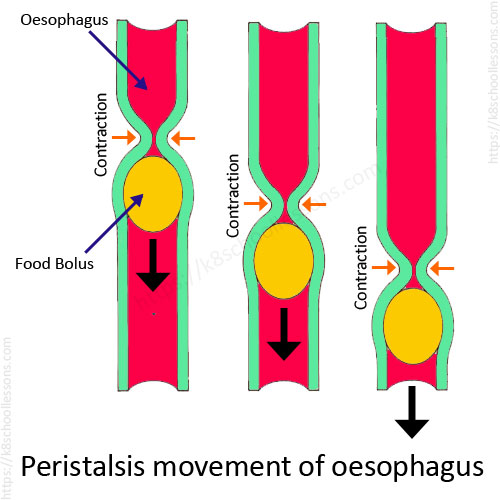 Peristalsis movement in oesophagus (gullet)
Peristalsis movement in oesophagus (gullet)
The powerful muscles that make the entrance and exit of the stomach are called sphincters. This entrance is usually closed tight, but when food approaches sphincters relax to let food enter the stomach.
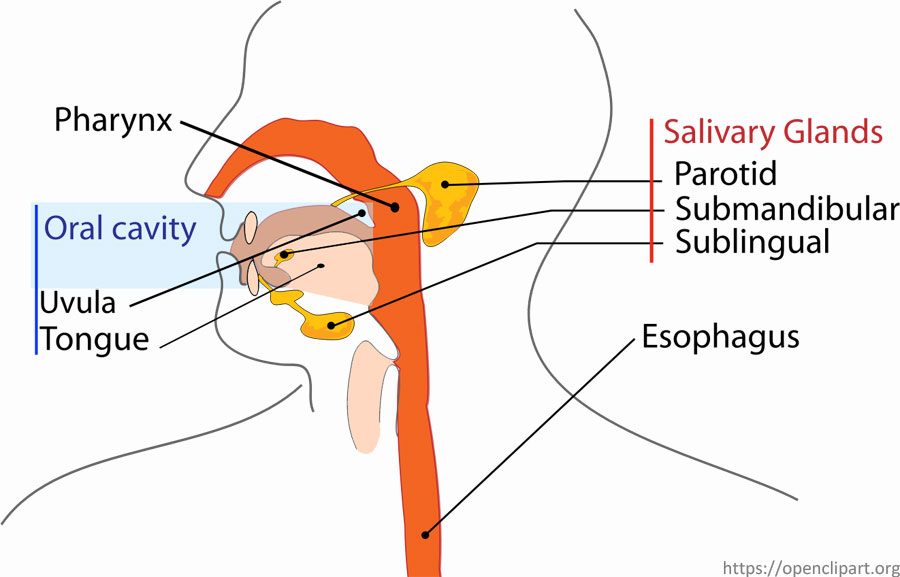 Upper Part of the Human Digestive System
Upper Part of the Human Digestive System
Click to go back to the contents
As you know, in ten seconds the food you swallowed travels down the oesophagus into the stomach. The stomach is a large muscly bag. It can stretch up to 20 times its size to hold a full meal.
Physical and chemical digestion
The stomach breaks down the chewed-up food and protein digestion begins here. The powerful muscular wall of the stomach squeezes and mixes the food with digestive juices churning it into a creamy liquid called chyme.
The stomach’s wall has tiny openings which lead to deep holes called stomach glands or gastric glands. The food arrives in the stomach is drenched in gastric juice released by these glands and protein in the food starts to digest.
Digestive juices in the stomach contain a very strong acid called hydrochloric acid. It can digest meat and even small pieces of bones. The stomach lining is covered with a layer of protective, jelly-like mucus to prevent hydrochloric acid damaging the stomach.
Click to go back to the contents
The small intestine is six-metre-long tube, which is coiled up below the stomach and the liver. It is lined with millions of tiny finger-like things called villi. These villi give the small intestine a folded surface so that the wall of the small intestine can collect all the important nutrients in the food.
Did you know?
The villi that line your small intestine would cover an area about the size of a tennis court, if you were to spread them.
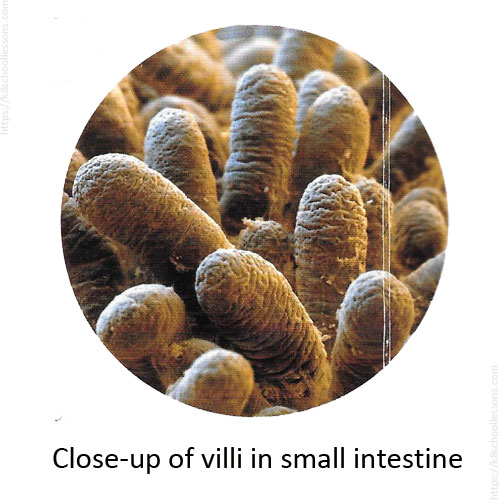 Villi in small intestine of the human Digestive system
Villi in small intestine of the human Digestive system
Chemical digestion and the absorption of nutrients into the bloodstream
After leaving the stomach, food spends one to two days passing slowly through the intestines.
During this time, food is broken down into small molecules of nutrients and fully digested. The enzymes produced by the villi of the small intestine’s wall, bile (produced in the liver and stored in the gallbladder), and pancreatic enzymes finish the digestion process.
The essential nutrients, such as glucose and amino acids pass through the villi of the small intestine’s wall and into the bloodstream. This is called absorption.
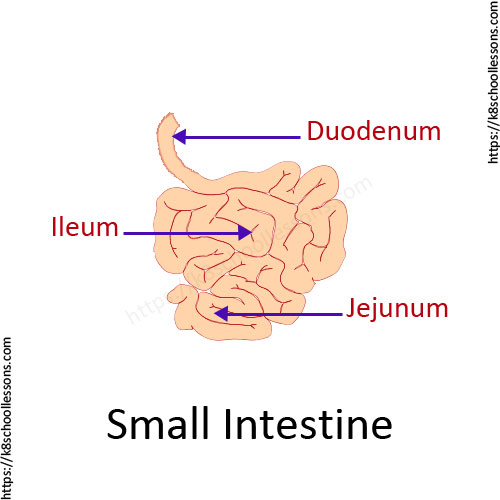 Small intestine of the Human Digestive System
Small intestine of the Human Digestive System
Click to go back to the contents
Also, known as colon. Large intestine is about 1.5m long. Though it is shorter than the small intestine, the large intestine has got its name as its diameter is bigger than the small intestine.
Absorption of water from the food remains
The remaining food particles leave the small intestine and enter the large intestine. By the time liquid food reaches the large intestine, most useful nutrients have been removed. The large intestine then absorbs most of the remaining water, leaving waste material and bacteria to be pushed out through the rectum as faeces (poo). It takes 10-12 hours for the food to pass through the large intestine.
There are billions of friendly bacteria live in the large intestine. These bacteria are not harmful. We get these bacteria from the raw vegetables we eat, and also from some yoghurts.
Cecum is a cul-de-sac at the beginning of the large intestine which is connected to the junction of the small and large intestines.
Cecum helps to form feces by mixing partially digested food from the small intestine with bacteria.
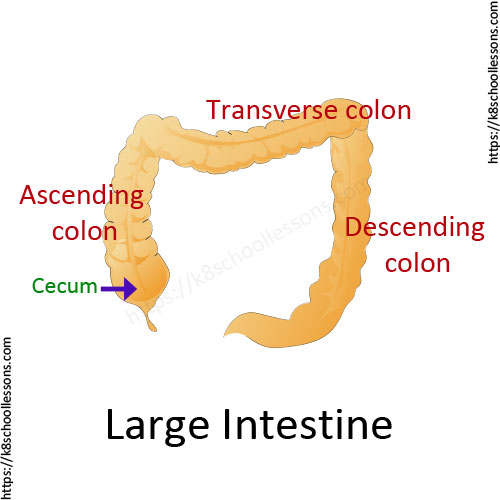 Large Intestine of the Human Digestive System
Large Intestine of the Human Digestive System
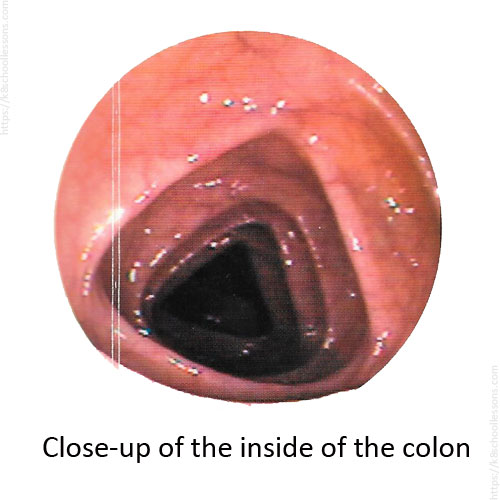 Inside view of the Large Intestine (Colon)
Inside view of the Large Intestine (Colon)
Listen to your food at work!
Have you ever felt that your intestines squeezing and moving your food? Also sometimes, you might have heard the rumbling given off by your tummy.
Put your ear close to a friend’s tummy and listen to the gurgle of liquid and air bubbles inside and enjoy listening to how food is busy working inside the tummy.
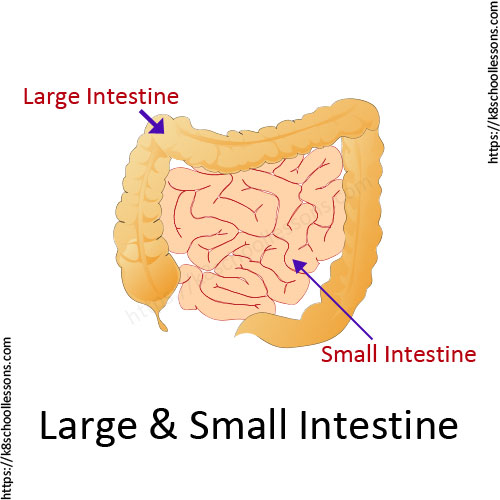 Small Intestine and Large Intestine
Small Intestine and Large Intestine
The appendix is joined to the intestines. It is a small tube that is closed at one end. It can be removed, if it becomes diseased, because we can absolutely live without it.
Click to go back to the contents
The remains of food and water is stored in the rectum.
Rectum is located in the bottom part of the large intestine. It is a stretchy, expandable pouch which stores the solid waste (faeces) pushed out of the large intestine. When you visit the toilet it can be pushed out through an opening called the anus.
Remember: Don’t forget to wash your hands after using the toilet. The waste matter that you pass from the digestive system is full of germs, such as bacteria, which can make you ill. These bacteria give poo its unbearable smell too.
Did you know?
Fibrous food make your poo large and soft, so that it can be easily pushed out through your gut. If you eat lots of root vegetables and have a high fibre diet, you can pass more poo without any difficulty and feel much better.
Amazing!
Passing wind, or farting, is perfectly normal and allows the body to get rid of gas that builds up inside the intestines. Everyone passes wind and the average person may do it up to 25 times a day, although they may be unaware of it.
Click to go back to the contents
Several other organs play an important role in helping the intestines to digest your food.
These are located high up in the abdomen, around the stomach and the first part of the small intestine.
Click to go back to the contents
The liver is an essential organ in your body which you cannot live without. Once the blood has collected nutrients from the small intestine, it passes them to the liver.
Did you know?
The liver can repair and regrow if its cells have been lost or damaged.
Click to go back to the contents
The liver makes a dark green or yellowish brown liquid called bile. This liquid is stored in a small bag called the gallbladder. Bile is released into the intestine when you eat something.
Bile turns food fat into tiny droplets that are easier to digest and absorb.
A newborn baby’s liver does not work properly for a few days. Until then, the coloured chemicals in bile can build up in the blood and turn the skin yellow. This is called jaundice.
Click to go back to the contents
The pancreas is a tail-shaped organ. It empties a complex mixture of digestive juices into the small intestine which we call pancreatic juices.
Some people do not make enough insulin themselves and have illness called diabetes. They may need to inject themselves with insulin everyday.
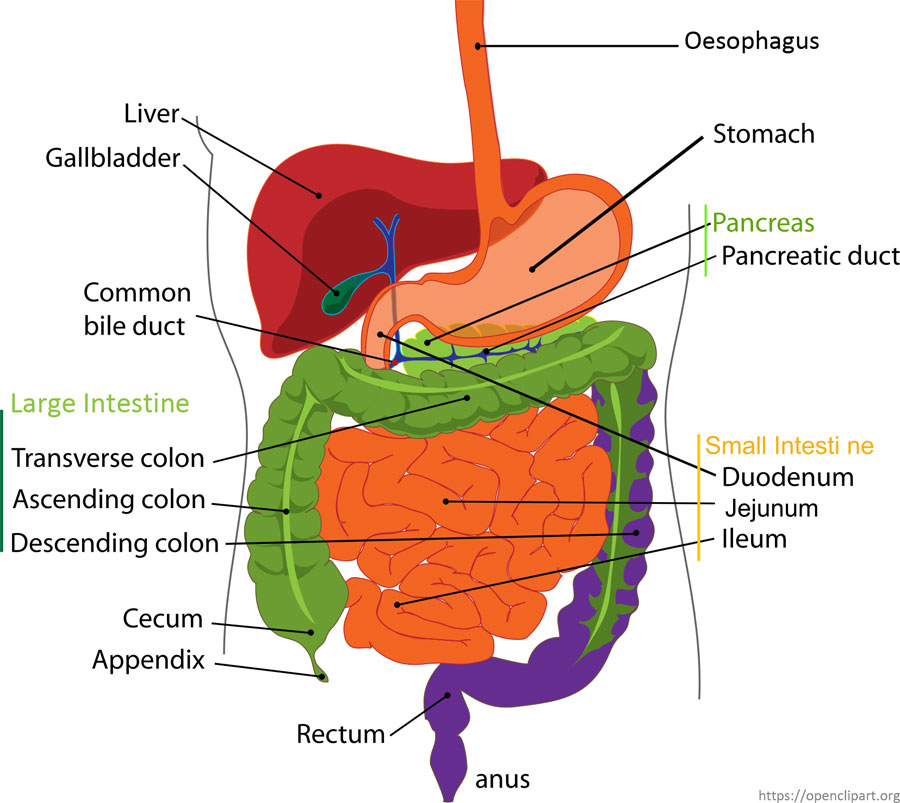 Lower Part of the Human Digestive System
Lower Part of the Human Digestive System
Click to go back to the contents
Hope you’ve enjoyed learning this lesson, Human digestive system for kids.